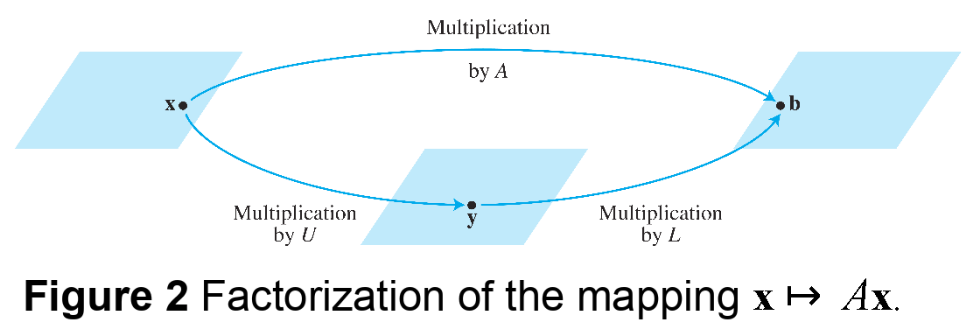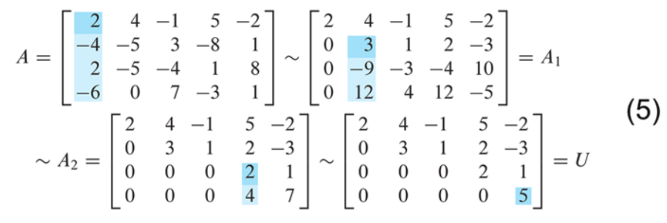Ch02. Matrix Algebra
2.5 Matrix Factorizations
Matrix Factorizations
- A Factorization of a matrix is an equation that expresses as a product of two or more matrices.
- Whereas matrix multiplication involves a synthesis of data (combining the effects of two or more linear transformations into a single matrix), matrix factorization is an analysis of data.
The LU Factorization
The LU Factorization is motivated by the fairly common industrial and business problem of solving a sequence of equations, all with the same coefficient matrix:
- When is invertible, one could compute and then compute and so on. However, it is more efficient to solve the first equation in the sequence (1) by row reduction and LU factorization of at the same time. Thereafter the remaining equations in sequence(1) are solved with the LU factorization.
- At first, assume that is an matrix that can be row reduction to echelon form, without row interchanges.
- Then can be written in the form , where is an lower triangular matrix with 1's on the diagonal and is an echelon form of .
- For instance, see Fig. 1 below. Such a factorizaton is called an LU factorization of . The matrix is invertible and is called a unit lower triangular matrix.
- Before studying how to construct and , we should look at why they are so useful. When , the equation can be written as .
- Writing for , we can find by solving the pair of equations
- First solve for , and then
- solve for .
See Fig 2. Each equation is easy to solve because and are triangular.

Example 1
It can be verified that
Use this factorization of to solve , where .
Solution :
The solution of needs only 6 multiplications and 6 additions, because the arithmetic takes place only in column 5.
- Then, for , the "backward" phase of row reduction requires 4 divisions, 6 multiplications, and 6 additions.
- For instance, creating the zeros in column 4 of requires 1 division in row 4 and 3 multiplication-addition pairs to add multiples of row 4 to the rows above.
- To find requires 28 arithmetic operations, or "flops"(floating point operations), excluding the cost of finding and . In contrast, row reduction of to takes 62 operations.
An LU Factorization Algorithm
- Suppose can be reduced to an echelon form using only row replacements that add a multiple of one row to another below it. (interchange없이 U로 축소시킴.)
- In this case, there exist unit lower triangular elementary matrices such that
- Then
- where
- It can be shown that products and inverses of unit lower triangular matrices are also unit lower triangular. Thus is unit lower triangular.
- Note that row operations in equation (3), which reduce to , also reduce the in equation (4) to , because . This observation is the key to constructing .
Algorithm for an L U Factorization
- Reduce to an echelon form by a sequence of row replacement operations, if possible.
- Place entries in such that the same sequence of row operations reduces to .
- Step 1 is not always possible,
but when it is, the argument above shows that an factorization exists.
square matrix이면서 interchange없이 row reduction을 수행하여 echelon form이 될 수 있는 경우에는 반드시 LU Factorization이 가능함 (충분조건으로, 역은 성립하지 않음.).
즉, interchage를 해야만 row echelon form이 되더라도 LU Factorization이 되는 경우도 존재함.
- Example 2 will show how to implement step 2. By construction, will satisfy using the same as in equation (3). Thus will be invertible, by the invertible matrix theorem, with . From (3), , and . So step 2 will produce an acceptable .
Example 2
Find an factorization of
Solution :
Since has four rows, should be . The first column of is the first column of divided by the top pivot entry:
Compare the first columns of and . The row operations that create zeros in the first column of will also create zeros in the first column of .
To make this same correspondence of row operations on hold for the rest of , watch a row reduction of to an echelon form . That is, highlight the entries in each matrix that are used to determine the sequence of row operations that transform onto .

The highlighted entries above determine the row reduction of to . At each pivot column, divide the highlighted entries by the pivot and place the result onto :

- An easy calculation verifies that this and satisfy
A 가 invertible 이면서 LU factorizatoin이 가능할 경우, U(A의 row echelon form)의 diagonal entries는 모두 1이 될 수 있으며, L의 diagonal entries에는 0이 존재 하지 않음(L이 triangular matrix이면서 invertible이기 때문임.). L도 모든 diagonal entries를 1로 만들기 위해서는 LU factorization을 조금 변형하여 LDU factorization으로 처리하면 됨. LDU의 경우, L과 U가 LU factorization과 달리 유일하게 결정됨(물론 D도 유일).